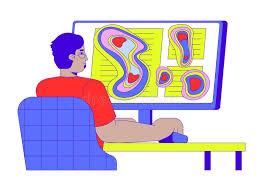Using Heatmaps to Improve UX and SEO Rankings

Introduction
User Experience (UX) and Search Engine Optimization (SEO) are some of the most important factors that determine success for a website. When UX is well optimized, this often results in increased engagement, lower bounce rates, and better conversions-all of which help attain better rankings on the SEO matrix.
Heatmaps represent one of the most effective instruments in the user behavior analysis for website improvement. Heatmaps reflect how a person interacts with the webpage by depicting it through pictures, thereby presenting actionable information, which would transform the experience to be user-friendly on a webpage.
Whenever the UX is improved, SEO goes up as it improves the time spent by increasing engagement and minimizing bounce rates.
What are heatmaps, and how do they work?
Heatmaps are graphic representations of user activity on a webpage, presented in the form of data through color-coded overlays. They allow a website owner to understand where users click, scroll, and hover and consequently optimize site layout and content placement.
Types of Heat Maps

Click Maps – provide insight into where users are clicking most, and therefore identify what elements are the most popular and which CTAs are ineffective.
Scroll Maps – These indicate the scrolling distance users travel down a page, thereby showing where content lies in strategic places.
Move Maps – They record the pattern of mouse movements that can give information on hover time before actual clicks occur.
Heatmaps form the core part of digital marketing and SEO by depicting behavioral patterns, which inform data-driven decisions in enhancing the usability and performance of websites.
Heatmaps and SEO

Heatmaps provide crucial information about users' behavior in order to ensure that the webpage is optimized correctly for better user engagement. SEO benefits of employing heatmaps are as follows:
Bounce Rate Reduction- Identifying issues that make a visitor leave a website quickly
Dwell Time Improvement- Optimization of user experience to increase user session time.
Dead Zones- Identification of webpage sections that people tend to skip and redesign.
A/B Testing Support – It helps test multiple layouts to decide which design element will help better conversion and engagement.
Optimize Web Pages by Heatmap Insight
To be able to harness the full benefit of heatmap insights, here are some strategies:
Click Maps: Analyze users' click behaviors to optimize calls-to-action placements.
Scrolly maps: Ensure content critical enough shows up before scroll stops.
Change Content Layout- Place text or images in order to read clearly and engage effectively.
Enhancing Visual Hierarchy – Prioritize elements that capture attention and guide users through the page efficiently.
Heatmaps and Mobile SEO Optimization
With mobile-first indexing, optimizing for mobile users is crucial. Heatmaps provide insights into how visitors interact with websites on mobile devices.
Mobile Heatmaps – Analyze touch interactions to refine design elements.
Thumb Zone Optimization – Ensure clickable elements are within easy reach for a seamless experience.
Mobile-friendliness – Optimize layouts for varying screen sizes to improve mobile usability and rankings.
Case Study: Real-World Example of How Heatmap Knowledge Led to SEO Success
E-commerce site leader used heatmaps to better understand user behavior and optimize their homepage. They had seen really high bounce rates and very few conversions. When they leveraged the knowledge of heatmaps:
CTAs were moved based upon where people click.
Important content was moved up within scroll maps.
Mobile usability was optimized to provide easier navigation.
Outcome:
35% dwell time.
20% decrease in bounce rate.
Improved keyword rankings because of better UX.
Heatmaps for Content Strategy and Internal Linking
Content strategy and internal linking structure will be greatly influenced by heatmaps:
Underperforming content – Improve sections that have low engagement.
Optimize internal links – Make sure the flow is smooth and links are placed strategically.
Guide users with a logical flow- Structure the content to take the user to the conversion goal.
Pro Tip: Use a JSON PDF generator to document heatmap insights for better reporting and analysis.
Best Heatmap Tools for UX and SEO Improvement
To get started with heatmaps, consider using these popular tools:
Crazy Egg – Offers click tracking, scroll maps, and A/B testing features.
Hotjar – Provides heatmaps, session recordings, and survey tools.
Microsoft Clarity – Free tool with advanced behavior analytics.
Google Analytics Behavior Reports – Tracks user interactions and engagement metrics.
Choosing the Right Tool: Features, pricing, and integrations help narrow down to the best heatmap tool for the need.
Conclusion
Heatmaps are essential in both UX and SEO rankings, giving insights on the behavior of the users. Through heatmap data, website owners can make decisions based on data for enhancing engagement, reducing bounce rates, and placing content effectively.
A data-driven approach to UX optimization leads to better search rankings and higher conversion rates. Start using heatmaps today to refine your website performance and gain a competitive edge in SEO.
More Updated Insights:
HTTPS vs. HTTP: Why Secure Websites Rank Better
How to Build Effective SEO Dashboards for Clients
The Role of Blockchain in SEO and Digital Marketing
SEO Attribution Models: Understanding Conversion Paths
Leveraging Knowledge Graphs for Enhanced Visibility
Combating Negative SEO: Protecting Your Website from Attacks
AI-Driven Competitor Analysis for Better SEO Strategies
Advanced Google Analytics 4 Configurations for SEO Insights
Mastering Schema Markup for Featured Snippets and Rich Results
Creating SEO-Optimized Content with Generative AI
Sustainability and SEO: How to Build Eco-Friendly Websites
Measuring ROI from SEO Campaigns: A Practical Guide
The Future of Backlinks in a Post-Link-Earning World
SEO for Niche Blogs: Standing Out in Small Markets
Optimizing Content for Google Discover: A Complete Guide
Ultimate Guide to Convert RAW to PDF Online: Free, Easy, and Efficient
- Art
- Causes
- Crafts
- Dance
- Drinks
- Film
- Fitness
- Food
- Games
- Gardening
- Health
- Home
- Literature
- Music
- Networking
- Other
- Party
- Religion
- Shopping
- Sports
- Theater
- Wellness


